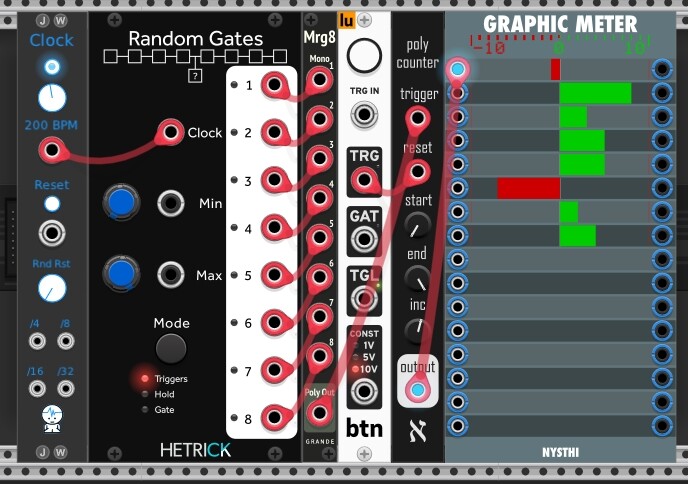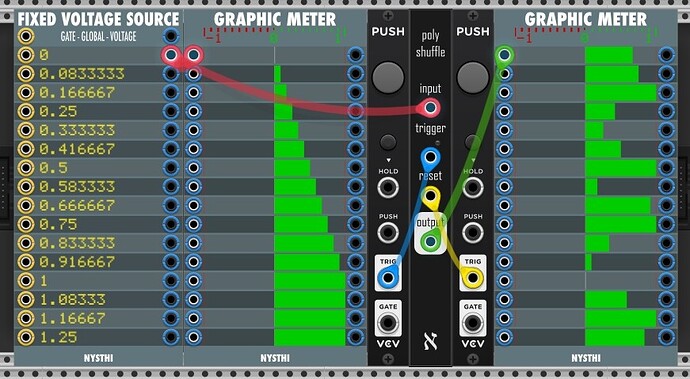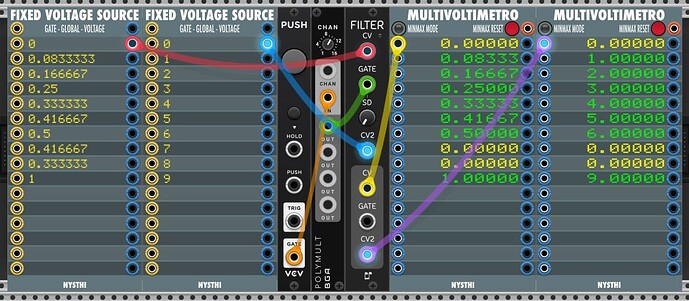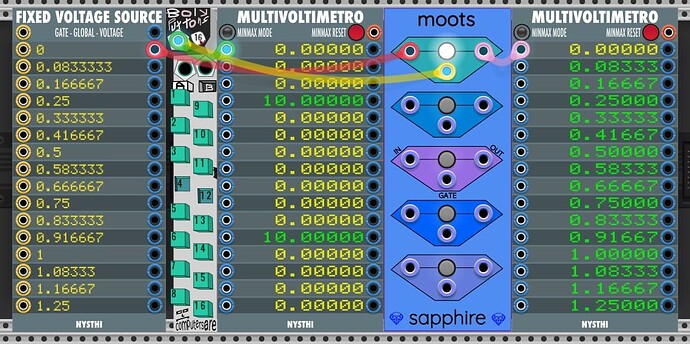@DaveVenom yeah I tried the Bogaudio pan, I think almost all their modules are polyphonic. Didn’t quite work how I expected, but updating your Venom Mix Pan sounds promising, thanks!
Bogaudio Pan doesn’t recognize polyphony unless the input is polyphonic. But once it is, then polyphonic CV can move the individual channels around the stereo field. The pan knob becomes an attenuator when the CV is patched, so you have to move the knob off of zero to have any CV effect.
My Mix Pan Expander in dev basically works the same.
Ah thanks, so you need to feed it poly modulation. I’ll give that a try, not sure why I didn’t think of that. Cheers!
polycounter (alef’s bits)
A polyphonic trigger input on a certain channel causes an increment of the value of that channel. Increment is set with the ‘inc’ knob. Values lie between start and end values. Rollover to start value when end value is reached.
UPC_polycounter (alefs bits)_20241008.vcvs (5.5 KB)

polyshuffle (alef’s bits)
Shuffle channels on trigger, while maintaining absolute values. Reset puts channels back in order.
Toly Pools v2 (computerscare)
Rotate channels of a polyphonic input signal, while maintaining absolute values. Can set number of output channels. Has output for number of input channels.
hello, may i ask for a polyphonic tool here,too? or is this thread only for listing and solutions?
Of course you are free to post (almost) anything you like.
However, to make your request more visible to interested developers, I would suggest to choose or create a more development-centric thread, such as: Ideas for any interested developers.
ok thank you. then i will describe it here and later in the mentioned thread. my problem: i want to replace notes inside a polyphonic signal. the polyphonic signal (16 channels) is a 16step sequence. so if replace e.g. the third channel, i replace the third step.
the hurdle is, that i want to do that during the running sequence. therefore i use infix from stoermelder to replace. because it is sensible for 0V i use mood from sapphire. then only the channel, that is triggered in mood go through. so far so good. that works.
BUT: i cannot patch a polyphonic signal to mood. i have to split and patch the sixteen channels to mood. i must use four of them.
is this intentional or is it possible to feed a polyphonic signal with gates to the gate input of mood to select? i am not able to do that.
second problem:
i want to first select the new note and step. then i need a trigger to through. that could be possible with triggerbuffer? but it is not latched, isn’t it?
btw: the whole thing is part of a bigger patch based on the performance /string patch from suzanne ciani. unfortunately many users/pc that tried to help could not run it. but i can upload it here to investigate. for now it is not documented well.
it is work in progress ![]()
but it is not neccessary related with my question/problem.
NoteFilter (Impromptu)
Filters out identical redundant notes in a polyphonic CV(1)/Gate/CV2 note signal; sets the duplicate channel values of CV(1) to zero, which also nulls CV2. Conversely, identical CV2 values (e.g. as accents) do not null CV(1), which makes sense. Requires polyphonic gate.
thank you.
i will investigate it today evening.
i am not sure if i understand it🤔
and if it works like i thought.![]()
@karlderletzte: The NoteFilter post was unrelated to your question ![]() .
.
Regarding Moots: @cosinekitty, don’t know, perhaps the Moots control input can be made polyphonic, too, so that only selected channels are being passed?
Include Amalgamated Harmonics’ PolyScope as a visualizer. Its most useful feature is possibly being able to offset each trace by a different amount with the “Spread” control.
MultiVoltimetro (NYSTHI) can also optionally sort poly channels in ascending (default) or descending order.
Thanks to this thread, I’ve learned that T’s Append and, apparently, Venom’s Multi Merge and Sparkette’s Stuff’s PolyCat do exactly what I’ve been looking for. Yay!
A few moments later…
I just had a facepalm moment when I discovered that Grande’s PolyMergeResplit also does it too. I’ve been using it for years but only as a conventional merge and split module. I never tried feeding poly signals into the top half.
i got the same result as your picture. if it is working correct, only channel 4 and 12 should go through. perhaps i have to ask @cosinekitty ?
ok, funny. then i don’t have to investigate.![]()
Thank you for your suggestions! Done.
i just find out, that polymult16+ from sickozell could solo and mute channels by correct cv per channel. but either or, as far as i understand. which module could merge the both polyphonic signal. for example channel 3 solo from one signal merge with channel 1,2,4-16 from the other?
Added docB’s PLC module, my go-to for generating polyphonic fixed values.
together with ofs from docb it is very useful. i use it often.
Backtracking a bit regarding Moots. Polyphonic cables can have anywhere from 0 to 16 channels. If you patch a cable with 0 channels to an input, the input treats it as though there isn’t a cable there at all. Moots is a switch that converts a poly signal with N channels into a 0 channel cable on demand.
It is not possible to create a module that turns an individual channel within a poly cable off and leaves the other channels alone. So if you wanted to automate the inFix solution you indeed need 16 independent cables that can be “Mooted”, which requires 4 Moots modules. If you don’t want all those cables, then that avenue is a dead end.
I think I have a good solution - Venom Bernoulli Switch. I don’t think anyone has caught on yet to how versatile this fully polyphonic module can be. For your case it can function as a polyphonic switch. There are many different ways it could work for you. I will describe just one.
Start with the default initialized configuration, which has the mode set to Swap.
In the module context menu, set the “Polyphony control” to “All inputs”
Patch your default 16 channel poly signal into the A input. That represents your default sequence. Then patch a second cable with 16 candidate channels of alternate values into the B input. It could be the output of a 16 channel polyphonic random sample and hold.
Patch the A output to your poly sequencer (whatever you call it), and a mono trigger signal to the Trigger input.
Set the probability to a low value like say 5%.
Now every time it receives a trigger, each of the A channels will have a 5% chance of being replaced by the corresponding B channel. Done!
There are many, many variations for this use case. For example, you can use a polyphonic trigger signal to selectively trigger individual channels. You can use a poly probability CV to independently set the probability for each channel. You can change the mode of operation. In your case I think you want either Swap mode or Gate mode. I don’t think Toggle mode would work well for your application. Read the Bernoulli Switch documentation for more details. And don’t be afraid to ask a question, perhaps best as a new topic.



